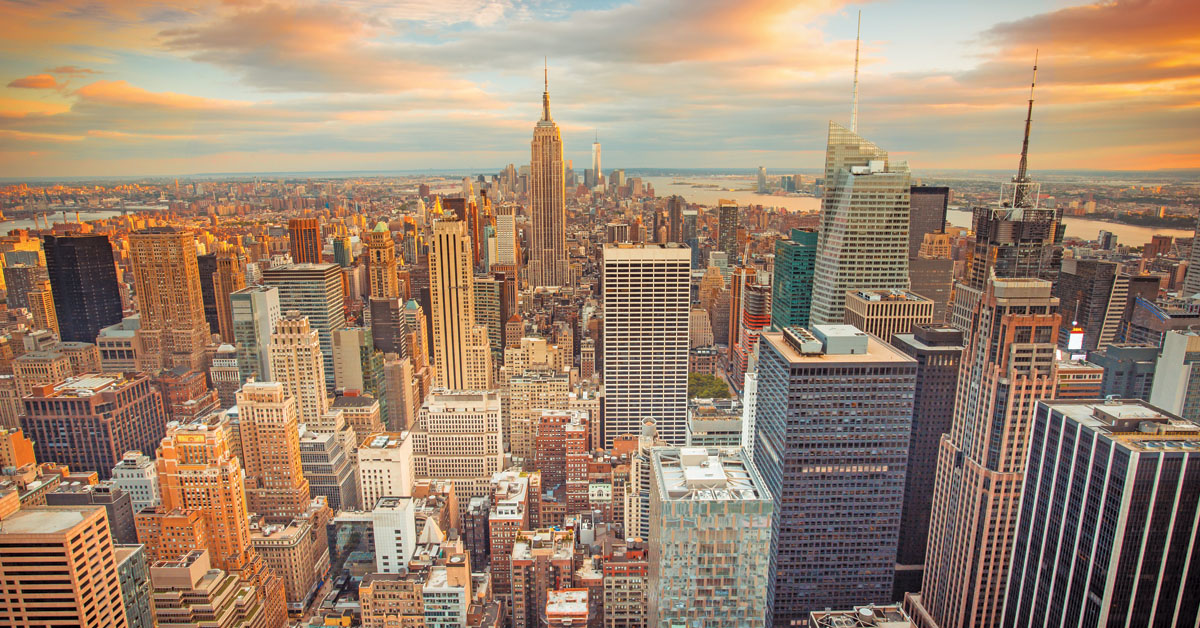The populous East Coast states of Delaware, New York, New Jersey and Pennsylvania were hit hard and early by the COVID-19 pandemic, and they’ve been slow to recover. This past July, only Delaware (5.6%) had an unemployment rate close to the U.S. average of 5.4%, while jobless rates were significantly higher in New Jersey (7.3%), New York (7.6%) and Pennsylvania (6.6%).
With that said, the Mid-Atlantic Region remains a magnet for corporations. Wages tend to be higher than the national average but so are the costs of living and property taxes.

The region is known for its big cities, including the nation’s largest — New York City and its metro-area population of 19 million people. The Big Apple’s metro footprint extends for 6,685 square land miles into the Hudson Valley and portions of Pennsylvania and New Jersey. Philadelphia’s metro-area population of 6.1 million is another major economic engine for this region. Other notable cities include Pittsburgh and Buffalo.
Although known for dense urban centers, the Mid-Atlantic Region has generally had stagnant or even negative population growth for several years. Only Delaware, with growth of 9.7%, experienced a significant influx of people in the 10-year period through July 2020. New York’s population shrank during this period while the cumulative growth rates in Pennsylvania and New Jersey were less than one percentage point.
New York has an annual gross domestic product (GDP) output of $1.7 trillion, which is the third largest among states after California and Texas. If it were a country, New York would rank No. 10 in the world, ahead of Canada, Russia and South Korea. But New York’s upstate region, home to more than 6 million people, has struggled since the Great Recession.
Quarterly GDP growth as of first-quarter 2021 ranged from 5.6% in Delaware and New Jersey to 6.6% in New York. Pennsylvania and New Jersey rank No. 6 and No. 9 in the country, respectively, for GDP output. Pennsylvania’s two distinct regions are centered by Philadelphia and Pittsburgh, a Rust Belt city that has evolved somewhat away from heavy manufacturing and steel to become a hub for tech startups.
New Jersey is an industrial center that feeds off an extensive highway system and proximity to the massive consumer markets of New York City and Philadelphia. A number of oil refineries are located in the state, while other major industries include pharmaceuticals and life sciences. Due to its favorable corporate laws, Delaware is the legal home to thousands of U.S. and foreign businesses.
This region — and New York City in particular — were among the first U.S. locations to be deeply hit by COVID-19. Unemployment rocketed into the double digits in each these states early in the pandemic. And while these rates have been more than cut in half, the regional average is still higher than other areas of the country. This past summer, infections were on the rise again due to the emergence of the delta variant, raising the specter of another potential shock to local businesses and tourism. ●

The office-vacancy rate in Philadelphia rose for three consecutive quarters and reached 15.6% in second-quarter 2021, up year over year by 150 basis points. The central business district (CBD) office-vacancy rate at this time was 13.7%, which was 200 basis points lower than the rate across Philadelphia’s suburban markets, Cushman & Wakefield reported.
The metro area also recorded negative net absorption for three consecutive quarters, including a loss of 660,335 square feet in second-quarter 2021. Despite the downward demand pressure, rents had grown for four straight quarters to hit $28.31 per square foot.
According to Cushman & Wakefield, companies are avoiding long-term leases. CBD office properties also are facing competition from oversupply in the suburban markets. Tenants were aggressively asking for improvement allowances and free rent as incentives to sign. One notable sales transaction occurred in the CBD in Q2 2021 as a 140,000-square-foot office property in the West of Broad submarket was purchased for $8.75 million.
Focus: Financial services
Manhattan, home to Wall Street, is the nation’s financial-services center. More than 90% of the state’s jobs in securities, commodities and other investments are located in downtown New York City. Much of the remainder of New York’s financial-services positions are based in the nearby Long Island and Hudson Valley areas. There are a total of 330,000 financial-services workers in the state of New York.
The business- and financial-services sector also accounts for roughly 17% of Philadelphia’s workforce, totaling nearly 112,000 jobs as of 2016 (the most recent available data). This employment sector rebounded well following the Great Recession, adding about 1,500 jobs in Philadelphia each year from 2013 through 2016, or 1.4% annual growth.
In New Jersey, meanwhile, the financial-services and insurance sector is a $33 billion industry that employs some 220,000 people. Four of the world’s top 100 fintech companies are based in the Garden State.
What the locals say
“We did see a peak [in New York City] before COVID, and it is hard to predict when we will get back there. But what I don’t see happening is a forever decline. I don’t think it’s like New York or other cities are on their way out and never coming back. There will be new reasons that people will want to be in the city. People want to live here. We did see a dip in rent pricing, whether it’s commercial or multifamily, but it is already starting to go back up. People are seeing New York’s investment potential. Eventually, we’ll get back to where it was pre-COVID. That’s my guess.”

Ryan Walsh
Partner
Hard Money Bankers
3 Cities to Watch
Buffalo

The second-largest city in New York, Buffalo has seen decades of flat or negative growth. Buffalo’s 2021 population of 886,000 was actually less than it was in 1950 (899,000). A turnaround in the city’s fortunes is projected to spur growth and a string of population gains beginning in 2024. Several commercial projects were in the planning or construction stages at the start of this year, including renovation of the 38-story Seneca One tower.
Newark

Newark was founded on land settled in 1666 by Puritans from Connecticut. The city is New Jersey’s largest with 282,000 residents and sits in the shadow of Manhattan’s towering skyscrapers across the Hudson River. Despite revitalization efforts, Newark has long had a problem with violent crime, and the poverty rate stood at 27.4% in 2019. In March 2021, however, a newly formed land bank in the city began accepting bids and redevelopment proposals on about 100 vacant lots as part of a citywide renewal effort.
Allentown

Ranked as the third-largest city in Pennsylvania with a population of 121,000, Allentown anchors the Lehigh Valley, the state’s fastest-growing region from 2010 to 2020. The city has seen a complete redevelopment of its downtown, spurred by state and local tax incentives through a so-called Neighborhood Improvement Zone. There has been more than $1 billion in new development since 2009, including an 8,500-seat hockey arena that hosts the Philadelphia Flyers’ farm team.
Sources: American Enterprise Institute; Britannica.com; CBRE; Choose New Jersey; Cushman & Wakefield; Economy League of Greater Philadelphia; Federal Reserve Bank of Philadelphia; Forbes; Investopedia; National Low Income Housing Coalition; Next City; NEXTpittsburgh; New York Bureau of Labor Market Information; State and Metropolitan Area Data Book; STR; The Buffalo News; U.S. Bureau of Economic Analysis; U.S. Bureau of Labor Statistics; U.S. Census Bureau; World Atlas; Yardi Matrix
Author
-

Victor Whitman is a contributing writer for Scotsman Guide and a former editor of the publication’s commercial magazine.
View all posts






